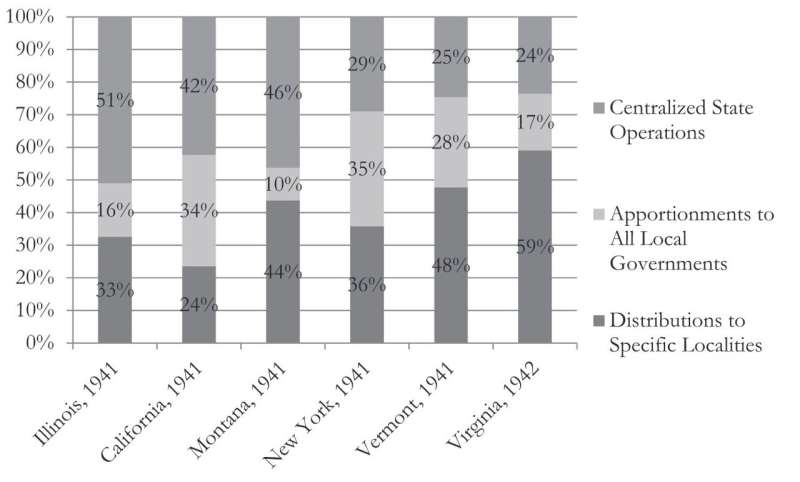This article has been reviewed according to Science X's editorial process and policies. Editors have highlighted the following attributes while ensuring the content's credibility:
fact-checked
trusted source
proofread
US state spending historically biased against immigrant, nonwhite communities, finds study

In 1936, when the influential American political scientist Harold Laswell published his seminal work Politics: Who Gets What, When, How, he couldn't have foreseen that the book's title would soon become a standard, lay definition of politics, one that endures to this day.
Given the importance of race, class, and immigration status in shaping American politics, two political scientists—Gerald Gamm at the University of Rochester and Thad Kousser at the University of California San Diego—wondered how demographic characteristics might affect state spending. Has state spending across constituencies reflected the same biases that have been shown to shape voting patterns, representation, and policymaking?
To answer that question, Gamm—an expert on Congress, state legislatures, urban politics, and modern party politics—and Kousser—a specialist on term limits, voting reforms, and state politics—took the long view, diving into historical archives and collecting data from six states for 1921, 1941, and 1961. The researchers picked this time frame to incorporate the sweeping changes in American society and government brought first by the New Deal and then the Second World War. Their results, titled "The Last Shall Be Last: Ethnic, Racial, and Nativist Bias in Distributive Politics," are published in Legislative Studies Quarterly.
As the title suggests, the duo found "clear evidence of bias" and discovered that race, class, and immigration status played important roles in how and where state legislatures spent money.
Examining historical budget and spending patterns from the state legislatures in California, Illinois, Montana, New York, Vermont, and Virginia—states selected to encompass the widest possible variety "in their region, party systems, size, level of urban development, and in their demography"—the authors discovered that certain demographic factors had a direct effect on how much a state spent on its constituents. Districts with more immigrants or larger numbers of nonwhite residents got significantly less money, while districts dominated by US-born, white Anglo constituents received more state dollars.
"We demonstrate that there is a strong and persistent bias in who gets what based on the demographics of constituents," Gamm and Kousser write.
The researchers examined 2,517 legislative districts, along with their legislators and constituent populations, to explain spending patterns. They controlled for a host of factors, across two categories, including non-demographic features of the districts and characteristics of the individual legislators.
"Legislators themselves have been the focus in most studies of distributive politics, as scholars have examined the advantages accruing to those with more seniority, those chairing committees, and those in the majority party," Gamm and Kousser write. But recent scholarship, they note, find the effect of these factors "quite modest."
The significance of the New Deal and post-World War II period
There's a reason that Gamm and Kousser stopped their historical analysis at 1961. It's likely the same reason previous scholars have not explored the relationship between district-level spending and demographics: to isolate and test a single explanatory factor in a complex political system encompassing 48 to 50 states, over any period of time, is daunting. To develop a database of every dollar in state spending targeting a specific district—as was necessary for the study—involved hand coding of entire state budgets, line by line, to isolate district-level spending. Some budgets took a full year to code.
Given those constraints, Gamm and Kousser were not able to collect and analyze data that would have shed light on the decades since, taking us up to the current moment when racial resentment, wealth inequality, and nativist fears have featured especially prominently in American politics.
But the period they studied offers a sound basis for speculation. The New Deal brought a period of rapid growth of public spending of all sorts—a trend that accelerated in the post-World War II period. Expectations about the role of government changed dramatically, and the terms were set for a debate that persists to this day over who should receive public funds.
So while the data cannot speak directly to the current era, the scholars conclude, "we speculate that the patterns of discrimination in state spending that we uncovered have persisted to the present day, given the evidence of continuing discrimination in other realms of American life."
More information: Gerald Gamm et al, The Last Shall Be Last: Ethnic, Racial, and Nativist Bias in Distributive Politics, Legislative Studies Quarterly (2023). DOI: 10.1111/lsq.12413
Provided by University of Rochester





















